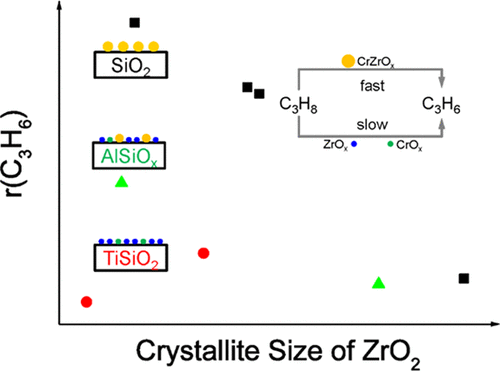当前位置:
X-MOL 学术
›
ACS Catal.
›
论文详情
Our official English website, www.x-mol.net, welcomes your
feedback! (Note: you will need to create a separate account there.)
Unraveling the Origins of the Synergy Effect between ZrO2 and CrOx in Supported CrZrOx for Propene Formation in Nonoxidative Propane Dehydrogenation
ACS Catalysis ( IF 11.3 ) Pub Date : 2020-01-08 , DOI: 10.1021/acscatal.9b05063 Shanlei Han 1, 2 , Yun Zhao 2 , Tatiana Otroshchenko 2 , Yaoyuan Zhang 1, 2 , Dan Zhao 1, 2 , Henrik Lund 2 , Thanh Huyen Vuong 2 , Jabor Rabeah 2 , Ursula Bentrup 2 , Vita A. Kondratenko 2 , Uwe Rodemerck 2 , David Linke 2 , Manglai Gao 1 , Haijun Jiao 2 , Guiyuan Jiang 1 , Evgenii V. Kondratenko 2
ACS Catalysis ( IF 11.3 ) Pub Date : 2020-01-08 , DOI: 10.1021/acscatal.9b05063 Shanlei Han 1, 2 , Yun Zhao 2 , Tatiana Otroshchenko 2 , Yaoyuan Zhang 1, 2 , Dan Zhao 1, 2 , Henrik Lund 2 , Thanh Huyen Vuong 2 , Jabor Rabeah 2 , Ursula Bentrup 2 , Vita A. Kondratenko 2 , Uwe Rodemerck 2 , David Linke 2 , Manglai Gao 1 , Haijun Jiao 2 , Guiyuan Jiang 1 , Evgenii V. Kondratenko 2
Affiliation

|
In this work, steady-state tests of propane dehydrogenation, density functional theory calculations, operando UV–vis spectroscopy, ex situ and in situ electron paramagnetic resonance spectroscopy, IR spectroscopy, and temperature-programmed techniques were combined to provide fundamentals for tuning activity and onstream stability of low-loaded catalysts with supported CrZrOx species. Two neighboring Zrcus (cus = coordinatively unsaturated) sites were concluded to be mainly responsible for propane dehydrogenation to propene. They are formed upon reductive catalyst treatment, and their concentration depends on the strength of interaction among CrOx, ZrO2, and support and on the size of ZrO2 crystallites in CrZrOx. SiO2 weakly interacting with CrOx was found to be a more preferable support than Al2O3- or TiO2-based supports. CrOx species promotes formation of Zrcus sites and improves their intrinsic activity for the desired reaction. CrOx also contributes to coke formation as concluded from operando UV–vis analysis. Cr20Zr80/SiO2 possessing about 3.9 or 2.5 times lower amounts of chromium or zirconium in comparison with an analogue of industrial K-CrOx/Al2O3 or state-of-the-art Ru/LaZrOx revealed about 2 times higher space-time yield of propene at 30% propane conversion at 550 °C. Moreover, this catalyst was durable over 50 dehydrogenation/regeneration cycles lasting 150 h.
中文翻译:

阐明ZrO 2与CrO x在负载型CrZrO x中协同作用形成丙烯在非氧化丙烷脱氢中的作用的起源
在这项工作中,丙烷脱氢的稳态测试,密度泛函理论计算,紫外可见光谱,非原位和原位电子顺磁共振光谱,红外光谱和温度编程技术相结合,为调节活性和降低温度提供了基础。负载型CrZrO x物种的低负荷催化剂的在线稳定性。结论是两个相邻的Zr cus(cus =配位不饱和)位点主要负责丙烷脱氢为丙烯。它们在还原催化剂处理而形成,它们的浓度取决于相互作用的的CrO之间的强度X,的ZrO 2,和支撑并在ZrO2上的尺寸2CrZrO x中的微晶。发现与CrO x弱相互作用的SiO 2是比基于Al 2 O 3或TiO 2的载体更优选的载体。CrO x物质促进Zr cus位点的形成,并改善其对于所需反应的内在活性。根据操作紫外可见分析得出的结论,CrO x也有助于形成焦炭。与工业K-CrO x / Al 2 O 3的类似物或最新的Ru / LaZrO相比,Cr20Zr80 / SiO 2的铬或锆含量低约3.9或2.5倍x揭示了在550°C下丙烷转化率为30%时,丙烯的时空收率提高了约2倍。此外,该催化剂在持续150小时的50个脱氢/再生循环中具有持久性。
更新日期:2020-01-08
中文翻译:

阐明ZrO 2与CrO x在负载型CrZrO x中协同作用形成丙烯在非氧化丙烷脱氢中的作用的起源
在这项工作中,丙烷脱氢的稳态测试,密度泛函理论计算,紫外可见光谱,非原位和原位电子顺磁共振光谱,红外光谱和温度编程技术相结合,为调节活性和降低温度提供了基础。负载型CrZrO x物种的低负荷催化剂的在线稳定性。结论是两个相邻的Zr cus(cus =配位不饱和)位点主要负责丙烷脱氢为丙烯。它们在还原催化剂处理而形成,它们的浓度取决于相互作用的的CrO之间的强度X,的ZrO 2,和支撑并在ZrO2上的尺寸2CrZrO x中的微晶。发现与CrO x弱相互作用的SiO 2是比基于Al 2 O 3或TiO 2的载体更优选的载体。CrO x物质促进Zr cus位点的形成,并改善其对于所需反应的内在活性。根据操作紫外可见分析得出的结论,CrO x也有助于形成焦炭。与工业K-CrO x / Al 2 O 3的类似物或最新的Ru / LaZrO相比,Cr20Zr80 / SiO 2的铬或锆含量低约3.9或2.5倍x揭示了在550°C下丙烷转化率为30%时,丙烯的时空收率提高了约2倍。此外,该催化剂在持续150小时的50个脱氢/再生循环中具有持久性。











































 京公网安备 11010802027423号
京公网安备 11010802027423号